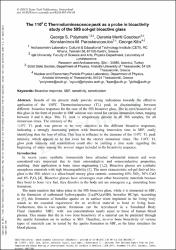The 110°C Thermoluminescence peak as a probe in bioactivity study of the 58S sol-gel bioactive glass
Künye
Polymeris, G. S., Goudouri, O. M., Paraskevopoulos, K. M., & Kitis, G. (2012). The 110°C thermoluminescence peak as a probe in bioactivity study of the 58S sol-gel bioactive glass. Paper presented at the , 493-494 49-54. doi:10.4028/www.scientific.net/KEM.493-494.49Özet
Results of the present study provide strong indications towards the effective application of the 110°C Thermoluminescence (TL) peak in discriminating between different bioactive responses for the case of the 58S bioactive glass. The in vitro bioactivity of this glass in the form of powder in SBF solution was tested for various immersion times, ranging between 0 and 6 days. This TL peak is ubiquitously present in all 58S samples, for all immersion times. The intensity of the 110°C TL peak was proven to be very sensitive to the different bioactive responses, indicating a strongly decreasing pattern with increasing immersion time in SBF, easily identifying thus the loss of silica. This loss is reflected to the decrease of the 110°C TL peak intensity, which appears to be fast even for the shorter immersion times. The 110°C TL glow peak intensity and sensitization could also be yielding a time scale regarding the beginning of some among the several stages included in the bioactivity sequence.
Kaynak
Key Engineering MaterialsCilt
493-494Bağlantı
https://hdl.handle.net/11729/741http://dx.doi.org/10.4028/www.scientific.net/KEM.493-494.49


















